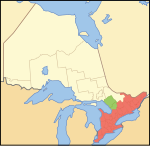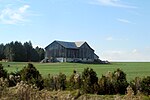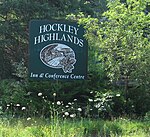Will O' Wind Farm
Buildings and structures in Dufferin CountyCanadian sports venue stubsEquestrian venues in OntarioSports venues in OntarioVenues of the 2015 Pan American Games
Will O' Wind Farm is an equestrian facility in Mono and was official host venue for the cross-country phase of eventing at the 2015 Pan American Games held in Toronto.The facility was opened in 1979 by Ann and Geoff Morgan. The venue has hosted national and international events to FEI Three Star level and has hosted the Ontario Provincial Eventing Championships in on three occasions. Will O' Wind also hosts schooling shows and clinics throughout the summer. For the 2015 Games the venue was bought up to FEI Three-Star standards and seating was located in clusters all over the course.
Excerpt from the Wikipedia article Will O' Wind Farm (License: CC BY-SA 3.0, Authors).Will O' Wind Farm
5th Line EHS,
Geographical coordinates (GPS) Address Nearby Places Show on map
Geographical coordinates (GPS)
| Latitude | Longitude |
|---|---|
| N 44.034055555556 ° | E -80.0245 ° |
Address
5th Line EHS 874460
L9W 5Y2
Ontario, Canada
Open on Google Maps






